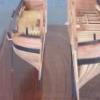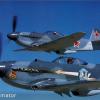MORE HANDBOOKS ARE ON THEIR WAY! We will let you know when they get here.
×
-
Posts
885 -
Joined
-
Last visited
Reputation Activity
-
 Julie Mo reacted to JohnE in Frégate d'18 par Sané , la Cornélie
Julie Mo reacted to JohnE in Frégate d'18 par Sané , la Cornélie
The rising wood (contre-quille) fairs into the apron (contre- étrave); a rather interesting timber.
The apron supports the heels of the ‘fourcats’ (forked, highly angled, frames from station VI forward), as well as the heels of the hawse timbers ahead of the “beakhead” frame (Station VII). There is a lot of vertical angularity going on here and the frame timbers need a rest stop to sit on.
In an earlier period, there was another member, the marsouins (the dolphins), fayed to the contre- étrave that had all the steps cut in, righty tighty. The dolphins because the timber went up-and-down, up-and-down, like a dolphin. In our period, the contre- étrave could be disposed with sufficient moulded dimension to accommodate the length of the chocks of the fourcat couples and the hawse timbers. In this case, the extension of the contre- étrave is sometimes also referred to as les marsouins.
The bottoms of all French frame timbers are substantially straight; there are no cheeks to speak of. The rising wood is cut with steps that receive each frame timber. A fourcat receives the same treatment, but being on a rising curve, needs a bit more attention; thus the marsouins or their alternatives.
Not so much forward, as aft, but nevertheless, the siding of the rising (marsouins) is decreased by twice the plank thickness in the lower hull area: slowly increasing until it reaches the nominal value in the neighborhood of bow planking having an appropriate angle of incidence to the stem rabbet.
As I mentioned, a very interesting timber.
Ciao. John
-
 Julie Mo reacted to JohnE in Frégate d'18 par Sané , la Cornélie
Julie Mo reacted to JohnE in Frégate d'18 par Sané , la Cornélie
The keel (quille), false keel (faux quille), and stem (l’etrave). Basic things, I know, but there’s some food for thought in even these beginnings.
Sané was quite complete in giving, not only the radius of curvature on the stem, but also the “rake” (elancement) of the member. Elancement has several translations, rake, elongation, overhang, and is a bit different from the normal quête (rake) in terms of specificity, although not in sense. Elancement of the stem is from the forward perpendicular to the top of the keel. From these two points, it’s an easy fit to a curve with specified radius.
The keel is moulded (height) 15 po and sided (thickness) 12 po. The keel extends into the stem by a forefoot timber (brion or ringeot) that extends the keel flat and adds a first portion of the stem curvature.
Although the orientation of the keel scarfs are irrelevant, the orientation of the brion scarf is somewhat important. If, as in the drawing, the angle of the scarf is away from the concave curvature of the wood, a compass timber need not have quite as severe a curvature. The same principal applies along the length of a curved member. Simply take an interior tangent along the endpoints of the concavity. Fiddly-bits, but something the yard-dogs would know very well.
The stem stars out moulded at 15 po, at the end of the keel, but gradually and gently slims down to 12 po, at the perp, which continues up to the tenon. Sided 12 po, all the while. The position and number of asarfs is completely arbitrary. The actual position and number will depend on the availability of appropriate compass timber. There is no rule.
Lot of fiddly-bits involved. More to come.
Ciao. John
-
 Julie Mo reacted to captainbob in Reading Boat Drawings
Julie Mo reacted to captainbob in Reading Boat Drawings
In that case, I'm glad you found us. There are a lot of good books on boat design. The one I bought first, many years ago, and still refer to is, "Skeen's Elements of Yacht Design" by Kinney. Boat design is very challenging, but it is also a lot of fun.
Bob
-
 Julie Mo reacted to mtaylor in Endeavour 1934 by Julie Mo - Amati - Scale 1:35 - America's Cup UK J-Class Challenger
Julie Mo reacted to mtaylor in Endeavour 1934 by Julie Mo - Amati - Scale 1:35 - America's Cup UK J-Class Challenger
I think we're all tool junkies here along with many of being bookaholics, kit addicts, and/or plan horders. There is no cure that I'm aware of. Dr. Per has topic for shipaholics but so far, no one has been cured to my knowledge. http://modelshipworld.com/index.php/topic/474-therapy-for-shipaholics/
-
 Julie Mo reacted to captainbob in Reading Boat Drawings
Julie Mo reacted to captainbob in Reading Boat Drawings
Frequently I find that although the height (draft) of the sections match the height of the profile, the width (beam) of the sections do not match the plan view. In this case you need to find the proper ratio of LOA to beam to draft. Then you know which to change. Sometimes the keel point on some sections do not meat the keel in profile. I measure from the base line to the keel point on the sections and transfer that dimension to the station lines in the profile. Draw a line through these lines. If the new line is not fair you know it is wrong and the sections need to be changed. If both lines are good you need to do more research to determine which is correct.
When a designer starts a new boat, the ratio of LOA to beam is set. If it is a racing boat, as you are drawing, it will be narrow for the length. If it is a pleasure boat it may be fat. The grid lines are laid down. He then draws the keel and shear in the profile, the deck line in the plan, and the widest section. He makes sure the points on all the lines as the cross the grid lines match. This is done for every curved line that is drawn. This goes on and on until the plans are finished. But mainly the designer wants every curved line to be smooth and fair. The main tool of the drafting board designer is the eraser.
All this being said, if you find only one or two lines that do not fit with the rest, change it, by eye, to be a smooth fit with all the rest. That's my lesson for today. lol.
Bob
-
 Julie Mo got a reaction from Eddie in Endeavour 1934 by Julie Mo - Amati - Scale 1:35 - America's Cup UK J-Class Challenger
Julie Mo got a reaction from Eddie in Endeavour 1934 by Julie Mo - Amati - Scale 1:35 - America's Cup UK J-Class Challenger
Packing for a late Wednesday move.
To be continued...
-
 Julie Mo got a reaction from Eddie in Endeavour 1934 by Julie Mo - Amati - Scale 1:35 - America's Cup UK J-Class Challenger
Julie Mo got a reaction from Eddie in Endeavour 1934 by Julie Mo - Amati - Scale 1:35 - America's Cup UK J-Class Challenger
John, I confess to being a tool junkie but any attempts at an intervention will be met with the utmost resistance including but not limited to temper tantrums, kicking, screaming, yelling and, if the intervener is persistent, very loud and shrill whining.
I support your purchase of the Liogier rasps and in the event making that purchase brings about any personal strife, I will appear on your behalf as a hopeless tool addict and show the need to own more tools is as important as breathing.
-
 Julie Mo got a reaction from hexnut in Endeavour 1934 by Julie Mo - Amati - Scale 1:35 - America's Cup UK J-Class Challenger
Julie Mo got a reaction from hexnut in Endeavour 1934 by Julie Mo - Amati - Scale 1:35 - America's Cup UK J-Class Challenger
Packing for a late Wednesday move.
To be continued...
-
 Julie Mo got a reaction from Canute in Endeavour 1934 by Julie Mo - Amati - Scale 1:35 - America's Cup UK J-Class Challenger
Julie Mo got a reaction from Canute in Endeavour 1934 by Julie Mo - Amati - Scale 1:35 - America's Cup UK J-Class Challenger
John, I confess to being a tool junkie but any attempts at an intervention will be met with the utmost resistance including but not limited to temper tantrums, kicking, screaming, yelling and, if the intervener is persistent, very loud and shrill whining.
I support your purchase of the Liogier rasps and in the event making that purchase brings about any personal strife, I will appear on your behalf as a hopeless tool addict and show the need to own more tools is as important as breathing.
-
 Julie Mo got a reaction from Dimitris71 in Endeavour 1934 by Julie Mo - Amati - Scale 1:35 - America's Cup UK J-Class Challenger
Julie Mo got a reaction from Dimitris71 in Endeavour 1934 by Julie Mo - Amati - Scale 1:35 - America's Cup UK J-Class Challenger
John, I confess to being a tool junkie but any attempts at an intervention will be met with the utmost resistance including but not limited to temper tantrums, kicking, screaming, yelling and, if the intervener is persistent, very loud and shrill whining.
I support your purchase of the Liogier rasps and in the event making that purchase brings about any personal strife, I will appear on your behalf as a hopeless tool addict and show the need to own more tools is as important as breathing.
-
 Julie Mo got a reaction from mtaylor in Endeavour 1934 by Julie Mo - Amati - Scale 1:35 - America's Cup UK J-Class Challenger
Julie Mo got a reaction from mtaylor in Endeavour 1934 by Julie Mo - Amati - Scale 1:35 - America's Cup UK J-Class Challenger
John, I confess to being a tool junkie but any attempts at an intervention will be met with the utmost resistance including but not limited to temper tantrums, kicking, screaming, yelling and, if the intervener is persistent, very loud and shrill whining.
I support your purchase of the Liogier rasps and in the event making that purchase brings about any personal strife, I will appear on your behalf as a hopeless tool addict and show the need to own more tools is as important as breathing.
-
 Julie Mo got a reaction from Canute in Reading Boat Drawings
Julie Mo got a reaction from Canute in Reading Boat Drawings
Bob, when redrawing, do you go with what looks good? Or do you follow something more precise?
I'm going to draw over the buttock lines next and insert them in place. I realize I won't have anything that replicates the sheer at the rail but maybe the level lines will provide some guidance. Whatever the case, I am enjoying this. I've been drawing boats since I was in grade school but I never had a clue how to do anything close to design.
-
 Julie Mo got a reaction from dgbot in Reading Boat Drawings
Julie Mo got a reaction from dgbot in Reading Boat Drawings
I think I'm beginning to understand boat drawings. I have seen line drawings many times but never stopped to figure out what is going on. It wasn't until I began my first model that I actually started to put it all together. But I'm not sure I have this right.
What I think I am seeing with the hull lines is the frames from the bow to midships on the right and from midships to stern on the left. So if you cut the drawing above down the middle, and took each half and made mirror images of the other half, you would have all the frames necessary to duplicate the shape of the hull.
Next you take those frames and place them where the vertical lines are on the above drawing, from "0" to "20". Then you plank it and you have the hull.
Am I on the right track?
-
 Julie Mo reacted to pete48 in VOLVO 65 by pete48 - FINISHED - Scale 1/4" = 1' - Farr Yacht Design
Julie Mo reacted to pete48 in VOLVO 65 by pete48 - FINISHED - Scale 1/4" = 1' - Farr Yacht Design
Hi Piet, You are absolutely right, just depends on the situation, ( in model building ) I always grab the X-acto first ( for almost everything )
Best Regards,
Pete
-
 Julie Mo reacted to PAnderson in HMS Bounty Launch by PAnderson - Model Shipways
Julie Mo reacted to PAnderson in HMS Bounty Launch by PAnderson - Model Shipways
Hello again. After careful consideration I have decided my next build will be the HMS Bounty Launch by Model Shipways. This will be my third build overall, after the most recent, the 18th Century Long boat. That was a delightful kit and let me hone my skills, even if it was in a small way. This should get me through Christmas and into the new year. Then Maybe I will have the courage to try something more ambitious.
I pulled the Bounty Launch out yesterday after fondling my USF Confederacy all day Saturday. This kit has pre-made planks. This will let me see what a properly spiled and bent plank should look like and let me work it out and learn a few more things. I do understand there will be some conservative fitting and not just slap on a plank. I started the keel last night and got all of the parts laminated and ready to go. This kit, as good as the laser cutting seems to be, seems to laser cut with no room for sanding. I sanded the char off pertinent edges and when I went to fit the stem pieces they no longer fit the plans. Like I said, no room for sanding. I had read one other log and he stated the same issue.
So, question. Would it be a good idea to shim at the scarf joints to build the parts out to fit the plans? The instructions say to explicitly follow the plans. Very well drawn and thought out CAD plans. So, if the parts were cut to CAD data, I could see how this would happen. So, the whole kit seems to be like this and I will need to be very careful.
Question: How much of the char needs to come off to take glue properly? I sanded to just before totally bare wood.
I will start to post pics very soon and I look forward to your ideas. I really like the friendliness and willingness to help on this site. I just wish I could contribute more and give back a little.
OK, I am getting long winded. This is my official start, wish me luck.
Paul
-
 Julie Mo reacted to Landlocked123 in Endeavour 1934 by Julie Mo - Amati - Scale 1:35 - America's Cup UK J-Class Challenger
Julie Mo reacted to Landlocked123 in Endeavour 1934 by Julie Mo - Amati - Scale 1:35 - America's Cup UK J-Class Challenger
Julie,
YIKES!!!!!! The idea of packing up 20+ years of accumulated stuff in my house, much less my workshop, gives the cold shivers and shakes. It makes me want to lock myself in my fly tying room with a half gallon of Johnny Walker.
Your comment above regarding the possibility of the Liogier Very Tapered Rasp showiing on your doorstep has completely convinced me that you are an unabashed tool junkie in serious need of an intervention!
-
 Julie Mo got a reaction from Canute in Reading Boat Drawings
Julie Mo got a reaction from Canute in Reading Boat Drawings
Thank you for the replies. I absorbing everything like a sponge.
I started taking the body lines and making full frames.
After rotating them into their 3D position, I placed the front frame lines in their respective locations.
Working from the inside toward the outside, I placed the frame lines at each point along the hull. I made an operator error that isn't so evident in this picture but I was able to fix it without a lot of trouble.
Next I placed the back half of the frame lines in position and moved them from stern to midships working inside to out.
As you can see, the back half didn't come out as well, relative to the keel line. If I moved the frames so they better line up with the keel line, the width of each frame line doesn't fair properly from one frame to the next and on from there. As it is in the picture above, they do. Since I was unable to decipher the frame numbers on the PDF, I just placed them according to their position on the body line drawing.
I was pretty exact when creating the body lines but the lines were a blur when zooming in close. And at the keel section, it was hard to tell if any of the lines crossed over one another. Some just melted into each other.
This is just an exercise to help me understand boat design and see how I fare. It's keeping me busy as we approach moving day. I doubt I'll ever use this for a scratch build but it's nice to use it as a learning experience.
-
 Julie Mo reacted to captainbob in Reading Boat Drawings
Julie Mo reacted to captainbob in Reading Boat Drawings
I find it rare to find accurate lines drawings. (If you have offsets they are usually better.) That's why I redraw them and make the necessary corrections.
Bob
-
 Julie Mo got a reaction from Eddie in Endeavour 1934 by Julie Mo - Amati - Scale 1:35 - America's Cup UK J-Class Challenger
Julie Mo got a reaction from Eddie in Endeavour 1934 by Julie Mo - Amati - Scale 1:35 - America's Cup UK J-Class Challenger
Per, I would suggest first buying one modeler's rasp, 6-7", with maybe a 13 grain. You will find this a pretty versatile tool and you'll get a feel for what they do without having to buy a set. It's easier on the pocketbook pain. If you need others, you can gauge what you need based on your experience with the first rasp. Craftsman Studio carries Auriou and has free shipping on orders over $75, which is pretty much every Auriou rasp, so shipping costs won't be an issue buying one at a time.
I have the Auriou needle rasp set that I have found very useful in this build. I also have a few rifflers that have come in handy, too.
Liogier has what they call a "very tapered rasp" they describe as: Due to their very small cross section and a very fine stitching grain, these rasps allow a perfect finish and provide access to hard to reach parts with sandpaper. They are also used in model-making or to make miniature objects. It looks interesting as a model builder's tool. I am too new to this to make any real assessment but I may one day find one of them in a package on my doorstep.
-
 Julie Mo got a reaction from mtaylor in Reading Boat Drawings
Julie Mo got a reaction from mtaylor in Reading Boat Drawings
Thank you for the replies. I absorbing everything like a sponge.
I started taking the body lines and making full frames.
After rotating them into their 3D position, I placed the front frame lines in their respective locations.
Working from the inside toward the outside, I placed the frame lines at each point along the hull. I made an operator error that isn't so evident in this picture but I was able to fix it without a lot of trouble.
Next I placed the back half of the frame lines in position and moved them from stern to midships working inside to out.
As you can see, the back half didn't come out as well, relative to the keel line. If I moved the frames so they better line up with the keel line, the width of each frame line doesn't fair properly from one frame to the next and on from there. As it is in the picture above, they do. Since I was unable to decipher the frame numbers on the PDF, I just placed them according to their position on the body line drawing.
I was pretty exact when creating the body lines but the lines were a blur when zooming in close. And at the keel section, it was hard to tell if any of the lines crossed over one another. Some just melted into each other.
This is just an exercise to help me understand boat design and see how I fare. It's keeping me busy as we approach moving day. I doubt I'll ever use this for a scratch build but it's nice to use it as a learning experience.
-
 Julie Mo reacted to JohnE in Reading Boat Drawings
Julie Mo reacted to JohnE in Reading Boat Drawings
Hi Julie.
I'm doing much the same thing on a different model. I'm going towards wood and not 3-D, but same, same.
Can help. Shoot me a pm. I routinely use Corel and TurboCAD, but AutoCAD is a no-brainer.
John
-
 Julie Mo reacted to captainbob in Reading Boat Drawings
Julie Mo reacted to captainbob in Reading Boat Drawings
Basically what you said and what you have drawn is true. If you add all the section drawings at the correct place you will have a 3D drawing of the boat hull. Once you get skin on the hull you can cut across it at any location and get a new section. If the frames on the boat are at every 9 inches then a cut at every 9 inches will give you all the frame shapes.
I build POB and usually use only every third or fourth section lines that are drawn for my bulkheads. That is plenty to support the planking. Just remember as you are drawing, the lines are usually to the outside of the hull, so you need to remove the thickness of the wood you plan to plank with.
Bob
-
 Julie Mo got a reaction from aviaamator in Spokeshave
Julie Mo got a reaction from aviaamator in Spokeshave
I have used spokeshaves for shaping guitar necks. I love working with them. Years ago I bought a couple of Record spokeshaves and hated them. When I got into making guitar necks, I bit the bullet and bought a set of L-N Boggs spokeshaves and never looked back.
Flat & curved soles
I can achieve a pretty straight cut with the spokeshave but for the final shaping I have several sanding blocks I made out of MDF to which I attach PSA sandpaper. These sanding blocks from 3" to 18" long. It takes time to get the final shape right and I use templates to check at different locations on the back of the neck as I do the shaping.
When it comes to using spokeshaves on a mast for a model boat, I do not see it as the best tool. As Michael mentioned, a small block plane would work better. The problem with using a spokeshave on something as small as a model mast comes in the flexibility of the wood. You would need a rigid backer to keep it straight and ensure even shavings. When I make guitar necks, flex is not a problem.
I plan on creating a mast with an oval shape. I will start with a small block plane and finish with long sanding blocks. I will make templates to check the shape as I work. There may be an easier way, short of CNC, but I don't know what that would be.
-
 Julie Mo got a reaction from Canute in Reading Boat Drawings
Julie Mo got a reaction from Canute in Reading Boat Drawings
Let's see if I am on the right track...
I took a line drawing of Endeavour II and drew over the body, breath and sheer level lines (do I have those terms correct?)
Then I put it into 3D and rotated the lines to get them into the correct x,y,z planes
So if I draw in all the buttock lines and orient them properly, I should have a 3D line drawing.
If I take those same buttock lines and create planes with them and loft them, I should be able to create a 3D hull.
If I'm missing something, please let me know.
Thanks,
Julie
-
 Julie Mo got a reaction from Canute in Reading Boat Drawings
Julie Mo got a reaction from Canute in Reading Boat Drawings
Mark, thanks for the link. I had been on that page but missed that particular article. I read through it and I think I pretty much understand what's going on.
Next step for me will be to apply my understanding of all this into a CAD drawing. I have AutoCAD MEP, which is intended for mechanical, electrical and plumbing in buildings but I can make it work for modeling purposes. It will be interesting to see how this works out. German Frers, look out!









